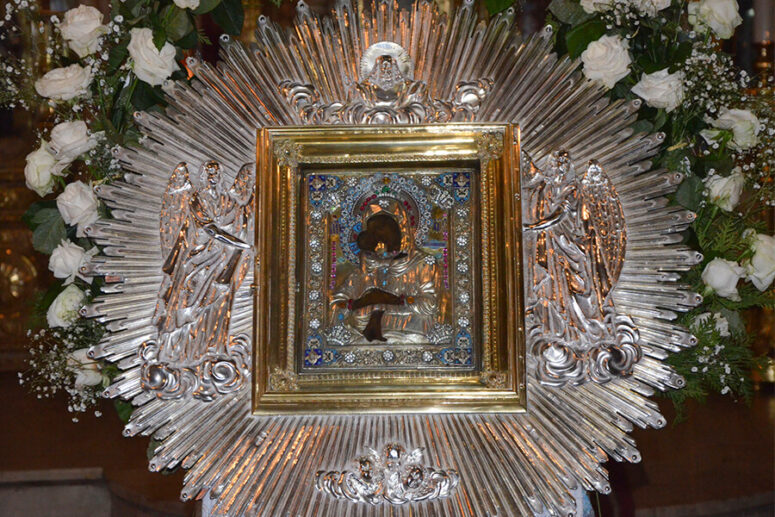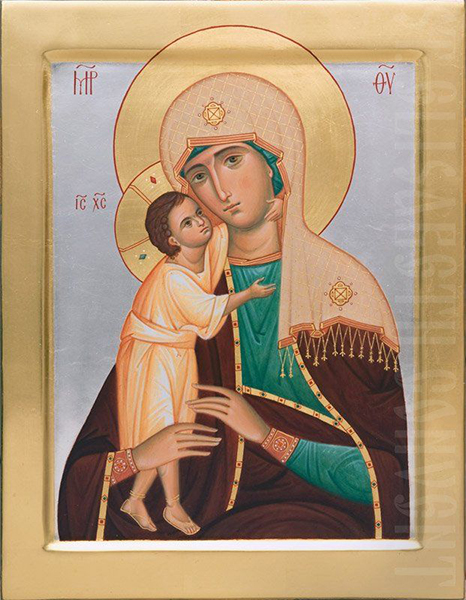
Seek us who are perishing, Holy Virgin, punish us not for our sin, but for love of mankind: deliver us from hell, sickness and want and save us.
(Troparion, Tone 4)
Recovery of the dead is one of many titles of the Most Holy Theotokos coming from the loving hearts of the faithful. The lost and perishing can count on the support of the Mother of God Herself, and Her help in leading her to salvation. “Dead” is a dreadful word; it means an irreversible loss for heaven and earth and oneself, and a pathetic casualty of the devil. But even beyond the point of no return, in the firm grip of death – physical and spiritual, we can count on Her miraculous intercession. The Most Holy Virgin will intervene on our behalf to recover our fallen and tormented soul with Her motherly love.
“Displaying the immensity of His grace, and the extent of His patience, He gave You, O Most Holy Virgin, to the people as their insurmountable protection. Whosoever is found worthy of condemnation by the righteous judgement of God will be granted reprieve through Your sovereign protection.
(Bishop Innocent of Kherson)
The first mention of the Icon of the Mother of God “Recovery of the Dead” dates back to the seventh century. The Life of Saint Theophilus of Adana presents a narrative of his falling into a deadly sin and miraculous salvation from eternal death by the intercession of the Most-Holy Theotokos. Theophilus, who was working as a housekeeper for a bishop, had been unfairly accused and expelled from the household. Seeking to revenge his accusers, he engaged with the forces of evil. Soon, he came to his senses, but he did not dare to ask God for His forgiveness directly but instead petitioned the Most Holy Theotokos. She answered his prayers quickly. Miraculously, Our Mother in Heaven informed the monk about his forgiveness and returned to him the contract with the devil that he had signed. The repentant monk grew in God and reached perfection in the spirit, and was glorified by the Church. This incident illustrates the origin of the name “Recovery of the dead” and the power of the intercession of the Virgin Mary as the last resort in the most difficult and desperate situations of our lives.
The details of the iconographic image of the Mother of God to which Theophilus prayed are uncertain, and there is a great variety in the depictions of the Mother of God in this icon. All images of the Theotokos with this title refer to the Eleusa type.
Rejoice, delivering us from all troubles by your strong intercession; Rejoice, protecting us from cowardice and flood. Rejoice, supplying us from the gladness of the soul and body; Rejoice, extinguishing the fire with the dew of Thy prayers. Rejoice, saving us from mortal destruction; Rejoice, strong Helper in battle. Rejoice, protecting us from the invasion of foreigners; Rejoice, guarding you from internecine warfare. Rejoice, passing easy on the waters; Rejoice, travelling good Guide. Rejoice, freedom of captives; Rejoice, speedy deliverance from the imminent righteous rebuke of God.
(Akathist to the Icon of the Mother of God “Recovery of the Dead”, Ikos 11)

Icons of the Most Holy Theotokos “Recovery of the Dead” have been painted in Russia by many generations of iconographers, but it became particularly well known in the 17th century. Fedot Obukhov, a pious peasant, was helping a very poor parish church of Bor Village of the Kaluga province, by sacrificing icons and vessels. On the eve of the Theophany, he was caught up in a snowstorm in the environs of Serpukhov. Fatigued, his horses stopped at the edge of an impassable ravine. Losing almost every hope of an escape, he cried from his heart to the Queen of Heaven and vowed to Her to make a copy of Her icon “Recovery of the Dead” and donate it to his parish church. Then he unbridled his horse, tied it to the sledge, lay down and covered himself up in the sledge as best as he could. Soon, he began to fall into delirium and was probably a few minutes away from freezing to death. But the eye of the Most Holy Theotokos was watching out for him.
A miracle happened: the sledge with the sledge and the unbridled horse was transported to the gates of a peasant from a neighbouring village. As he sat inside the peasant’s house, he heard someone say, “Here, take him in.” The host came to the gate, saw the horse and the sledge with Fedot Obukhov in it. They brought him in and returned him to life. After his recovery, he ordered a copy of the icon “Recovery of the Dead.” When it was finished, he carried it piously to his church. Painted in acknowledgement of the Fedot’s miraculous delivery from certain death, the icon worked multiple miracles. Each year, multiple people gathered to worship the icon, and with their donations, a new mortar church was built in the place of the old wooden church of the poor parish.
The Icon of the Holy Virgin “Recovery of the Dead” of Bor worked another notable miracle in 1871. It was the middle of a Cholera epidemic. The residents of Serpukhov had delivered the icon to the city. At the sight of the icon, a boy who was numb and could not walk suddenly said, “It is the recovery of the dead.” Immediately, he rose to his feet. With the icon in Serpukhov, the cholera epidemic in the city ended. From that day onwards, the annual holy cross procession from Bor to Serpukhov was held with the icon “Recovery of the Dead”. This tradition continued until the church in Bor was razed to its foundation during Soviet rule. The icon was lost and never found.
Some locally revered copies of the icon have survived, however. Some of the best known of those are found in Moscow, at the Church of the Renewal of the Church of the Holy Sepulchre, Saint Petersburg (Church of the Holy Protection at Marienburg), and Samara (Metropolitan Cathedral of the Holy Protection).

The icon at the Church of the Protection at Marienburg was painted at the initiative of Hegumeness Anatolia and sisters of the Holy Trinity Monastery of Samara Province to commemorate the miraculous escape from death of Emperor Alexander III and the Royal Family in a train crash in 1888. Temporarily, the icon was kept at Gatchina. In the 1950s, two parishioners of the Church of the Protection at Marienburg rediscovered the icon at gave it to the Church.

In 1666, a copy of the icon of the Holy Virgin “Recovery of the Dead” sailed down the river Volga to Saratov and appeared to the mortally wounded General Kadyshev. The general was healed. From that moment, the icon became the relic of this noble family, wringing miraculous forebodings and healings. Two centuries later, one of the general’s descendants established a monastery in Rakovka Village outside Samara, and the icon became its main relic. Soon, the miraculous healings attributed to this icon became the talk of all Russia. The icon travelled to many towns and cities, including Saint Petersburg, but the tradition of exhibiting it throughout the country stopped with the revolution. From 1953 to this day, it has been kept at Samara’s Metropolitan Cathedral of the Holy Protection.

In 1915, Saint Matrona of Moscow gave her blessing to the painting of a copy of the icon “recovery of the Dead”, with which she never parted to the end of her life, Today, it is found at the Convent of the Holy Protection in Moscow.

Grace is the pledge of having delighted in giving to our kindred, Thy celibate icon Thou didst show to us, O Mother of God, from inappropriate currents of miracles flowing with faith, non-women are healed and sorrows are satisfied. For this reason, we joyfully cry to God for You: Alleluia.
(Akathist to the Icon of the Mother of God “Recovery of the Dead”, Kontakion 12)
Is there any person who has never experienced sorrows or pains in their lives? The terrified spirit seeks solace in prayer, falls at the feet of the Holy Icons, vents his anguish and grief before the relic. One knows that their tearful prayer will not be rejected; that the lamentation of their heart will be heard. Grief will evaporate, the clouds will be blown away, the light of the Truth will shine in their heart. One will see the beauty of God’s word, one’s soul will come to its senses, and one will exclaim, “God is alive! My soul is alive, as my Tireless Protectress is close to me, granting Her grace-given help through Her miracle-working icons. Her quiet and peaceful abode is drawing in scores of people. Let us come to Her and cry from our hearts:
Zealous, blessed Lord Mother! I am running to Thee, I am an accursed and most sinful man, listen to the voice of my prayer and hear my cry and groaning. do not despise the wicked one, do not despise my sinful prayer, do not leave me accursed, Grant me the correction of our sinful life and instruct my soul that has gone astray on the right path. On You, my Lady Theotokos, I lay all my hope. Thou, Mother of God, preserve and keep me under thy roof, now and ever, and forever and ever. Amen.”
(From the prayer to the Icon of the Mother of God “Recovery of the Dead”)

Translated by The Catalogue of Good Deeds
Sources:
The Blessed Matrona of Moscow / 20th-century Orthodox ascetics — М.: Convent of the Holy Protection
Recovery of the Dead — Monastery of the Holy Trinity and St. Stephan Makhrishsky
“Recovery of the Dead” Icon of the Mother of God at Samara, 1901, 1902 (Margarita Biryukova)
https://obitel-minsk.ru/lutschije/2022/02/vzyschi-nas-pogibayuschix-presvyataya-devo




